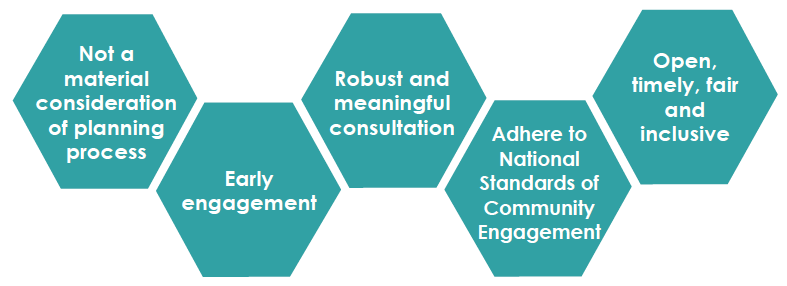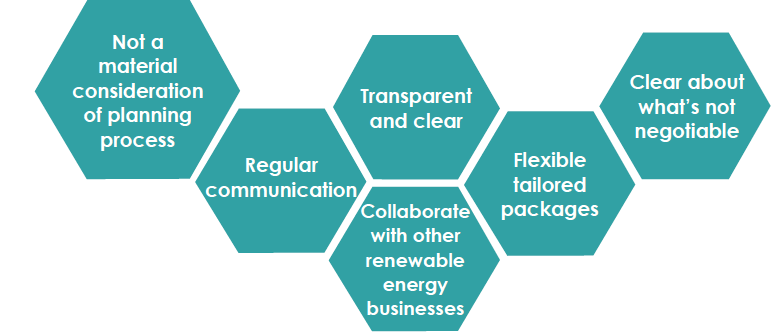Community benefits from onshore renewable energy developments
Guidance on good practice principles for communities, businesses, local authorities and others.
Community – Consultation and Identification
This section includes details on:
- Principles of consultation
- Approach to consulting
- Consulting on details of a community benefits package
- Identifying stakeholders
- Widening area of benefit
- Community Benefits Agreement
Principles of consultation
Consultation is an important component of identifying appropriate communities that will be involved in community benefits schemes. This can also help to avoid division and ill-feeling locally, helping to ensure the community benefits offer is viewed positively over the longer term.
The Scottish Government encourages this process to begin at an early stage, pre-consent where possible, to allow community groups time to consolidate their available resource and build capacity, as well as to enable discussion and identification of an appropriate area of benefit.
The creation of mutual trust and strengthening of relationships is integral to the overall process. Consultation should be open, timely, fair and inclusive; enabling everyone with an interest the opportunity to be involved and heard.
Principles of Consultation

Although local opponents to the development itself may deem such conversations inappropriate, in the longer term it is the considered view of the Scottish Government that early stage conversations help build engagement in and commitment to local renewable energy developments. Discussions on the provision of community benefits are not a material consideration in the planning process.
To maintain this distinction, Scottish Government recommends that discussions on the development itself and discussions on community benefits proposals are held in two separate forums or at separate times in the development process. However, it is recognised that this may not always be possible owing to the timescale of the project or available resource and capacity within a community. Therefore, when the concept of and approach to community benefits is introduced, it should be made clear to the community that it is independent of the planning process and is not a material consideration in deciding an application.
Approach to consulting

Renewable energy businesses and communities are encouraged to:
- Be transparent and clear during the consultation process, and be prepared to be flexible on the proposed boundary of the benefitting area, and what the community benefits will deliver (i.e. the proposed package and potential areas of needs and opportunity to be addressed).
- Ensure engagement with the wider community.
- Be clear at the outset which elements of the proposed community benefits package can be shaped by this consultation and which cannot.
- Be open to tailoring the community benefits package to a local community’s specific circumstances while retaining consistency across their portfolio (where appropriate).
- Identify any barriers to participation and how these will be addressed.
- To make themselves aware of other relevant renewable energy developments and existing/proposed community benefits packages and to communicate with each other and work together where possible and appropriate.
- Community members directly engaged in discussions with renewable energy businesses should ensure they are keeping local people apprised of progress, to avoid generating conflict or ill feeling amongst the wider community.
Consulting on details of the area of benefit and community benefits package
As a first step, the consultation on the specific area of the community benefits package should at least engage the same wider geographical area that formed the consultation on the development itself.
Fairness and transparency are key during the identification process. Favour must not be shown to particular individual groups or those with the strongest voices.
Discussions should:
- Initially involve every community council (where these exist).
- Where they don’t exist, other representative community bodies within the geographical area should be approached.
- Similar organisations representing those communities directly bordering the application site should also be approached.
- The renewable energy business may also wish to explore links with the relevant local authority (or authorities) who may be able to provide support during this stage.
- The renewable energy business should be aware of planned investment in the community through discussion with community representatives and the local authority as well as familiarisation with any existing community plan in the area. Community benefits discussions should acknowledge what is already happening, and whether a community benefits offer can contribute to that and ensure existing planned investment is not undermined.
- Using the boundary of the relevant community council(s) administrative areas as a starting point, the following factors may also be employed to help determine the appropriate geographical area that makes up the ‘area of benefit’ for a proposed community benefits package:
- Proximity to site – may give a starting point for identifying an area of benefit.
- Geography and topography – immediate, adjacent and/or surrounding postcode areas.
- Characteristics of development – its size, scale, siting and visibility.
- Construction – communities that will be affected most significantly by the construction of the development.
- Demographics – population density and spread.
- Any relevant local authority policy/guidelines.
This list is not exhaustive and factors selected may vary according to local context and renewable energy businesses’ corporate policies.

Identifying other local stakeholders
Following identification of an appropriate geographical boundary for consultation, renewable energy businesses are encouraged to engage with other relevant local stakeholders, which could include:
- Local residents.
- Local businesses.
- Land managers.
- Community councils (often likely to be an important lever into the wider community) or, if none exist, any other representative community body.
- Local authority Officials.
- Thematic groups and clubs, for example youth groups, sports groups, heritage groups, or lunch clubs for the elderly,
- Community development trust or community company.
- Housing associations and tenants associations.
- Other existing community groups.
- Local environmental bodies, and other national environmental non-governmental organisations with a local presence.
- Local Chamber of Commerce, Federation of Small Businesses, and/or Business Improvement District.
- Other key service providers, e.g. village hall committees, schools, colleges, healthcare facilities, residential facilities, care providers, community transport services, credit unions etc.
Widening the area of benefit
There may be an opportunity to be more flexible in terms of widening the geographical area of benefit to reach a greater number of individuals and organisations would could support projects that are area-wide. This may be appropriate for larger scale projects or where there are multiple benefits packages within the appropriate area of benefit.
Any decision to widen the area of benefit should form part of the discussions/consultation process with the community living within the boundary of the development area and, the renewable energy business.
For larger projects one option may be to split the community benefits package to allow both local and wider regional benefits, particularly where the longer term economic and social impacts are identified as a priority.
These type of arrangements are likely to be successful when implemented with grassroots engagement and support.
If part of the agreed community benefits package includes a community benefits fund, the consultation process may wish to consider how this might fit in with other operational funds that may already exist in the area.
Priorities for wider area arrangements should reflect the needs and aspirations of the region. Local authorities should be aware that guidelines cannot be enforced through the planning system and must remain as optional guidance.
Stakeholders should be aware that where funds are administered by a local authority, any awards made to community groups may be assessed as state aid and must comply with State Aid regulations. Local Authorities may wish to seek their own legal guidance on this.
Some additional factors to consider when identifying the area of benefit:
- Resource and capacity of communities: some communities may require additional support to contribute fully, while others will be able to draw on established networks.
- Other relevant stakeholder areas, including:
– The catchment area of any local schools
– Travel to work areas
– Neighbouring or nearby service centres or communities that serve the ‘primary communities’
Achieving majority support
Renewable energy businesses are encouraged to be sensitive to, and welcome, the many different views within the community and where possible seek a consensus over the area of benefit. We recognise that sometimes it is not possible to set out the area of benefit in advance of a planning decision being made.
It is good practice to produce a report on the consultation process, representations, and the outcome and to circulate to interested parties – whether they participated in the consultations or not. This should also be publicised on relevant local websites.
If individuals or groups opt out of community benefits discussions until a planning application has been made, it should be made clear that they will have the opportunity to re-join discussions at a later date, if that is indeed the case.
Local authority guidelines
Some local authorities have policies or guidelines to aid regional consistency in the administration and distribution of community benefits arrangements which can be helpful to frame discussions. This is one possible route. The renewable energy business and the community should discuss the relevant local authority approach, where there is one, and arrive at a mutual agreement on whether this is the most suitable pathway to follow. Local authorities should be aware that guidelines cannot be enforced through the planning system and must remain as optional guidance.
Review and agreement
The findings of the consultation should be shared with the wider community. Following which, there should be a process of review and discussion between the renewable energy business and a group of local people mandated to progress discussions about confirming the community benefits arrangements. This group may be the Community Council or other mandated representative group and may involve a relevant third party. When the Area of Benefit includes multiple communities the group should include representation of all those communities.
It is worth highlighting that discussions may take some time and changes in personnel will occur (both renewable energy business staff and community volunteers). There may also be considerable time between a project receiving consent and the start of its construction and subsequent commissioning. For this reason, it is recommended that all meetings are documented and shared with all involved in a public space.
Community Benefits Agreement
It is recommended that, when community benefits discussions between the renewable energy business and the community have concluded, arrangements agreed upon are formalised through a legal agreement between parties. These ‘parties’ will vary according to different contexts. For example, some renewable energy owners will want an agreement directly with a mandated community body and others will want to have the agreement with a relevant third party that will have overall responsibility for administering the community benefits package. Irrespective of the parties involved, at its most fundamental the agreement should detail:
- The proposed community benefits package, including the time period it covers.
- The proposed roles of all involved, including any third parties.
- The protocol for advising the community if a site is to be sold.
- A commitment to honour all agreements should the site be sold on with documents being passed to the subsequent owner.
The renewable energy business should also provide an ongoing clear point of contact. In some cases this could be a third party appointed by the renewable energy business to deliver the community benefits package, to ensure that the community groups are able to access relevant support going forward.
Contact
Email: lorne.frew@gov.scot
There is a problem
Thanks for your feedback